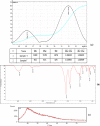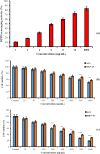Antioxidant activity and cytotoxicity of exopolysaccharide from mushroom Hericium coralloides in submerged fermentation
- PMID: 36277811
- PMCID: PMC9579569
- DOI: 10.1007/s13399-022-03386-0
Antioxidant activity and cytotoxicity of exopolysaccharide from mushroom Hericium coralloides in submerged fermentation
Abstract
Mushrooms of the genus Hericium spp. represent a series of delicious edible mushrooms with medicinal value. Here, for the first time, the species native to Iran, the mushroom Hericium coralloides, was collected in Mazandaran province, identified, and registered with the NCBI under accession number MW136052. The production of exopolysaccharides (EPS) in submerged culture was optimized using the response surface method. Among the physicochemical and culture medium conditions tested, rotation speed and concentration of maltose and peptone of soybean significantly affected the production of EPS. The proposed model predicts maximum EPS production (0.13 g/L) at 50 g/L maltose, 3 g/L soy peptone, and 1 g/L yeast extract, pH = 6.5, 200 rpm, inoculum at 5% v/v, and 22 °C. The molecular weight of the EPS chains was 413 and 1578 Da. EPS has antioxidant action (EC50 = 6.59 mg/mL) and cytotoxic activity against cancer cells. The viability of AGS and MKN-45 cancer cell lines declined to 20 and 30% after 48 h of the EPS treatment. H. coralloides EPS could be considered a natural dietary anti-cancer supplement. Further studies are necessary to understand the mechanism of the H. coralloides EPS activity on the cell cycle of cancer cells and to prove its action in vivo.
Supplementary information: The online version contains supplementary material available at 10.1007/s13399-022-03386-0.
Keywords: Anticancer; Antioxidant; Exopolysaccharide; Hericium coralloides; MW136052; Optimization; Submerged culture.
© The Author(s), under exclusive licence to Springer-Verlag GmbH Germany, part of Springer Nature 2022, Springer Nature or its licensor holds exclusive rights to this article under a publishing agreement with the author(s) or other rightsholder(s); author self-archiving of the accepted manuscript version of this article is solely governed by the terms of such publishing agreement and applicable law.
Conflict of interest statement
Competing interestsThe authors declare no competing interests.
Figures




Similar articles
-
Production of bioactive exopolysaccharides from bitter medicinal mushroom, Antrodia camphorata (M. Zang et C.H. Su) Sh.H. Wu et al. (Aphyllophoromycetideae) in submerged cultivation.Int J Med Mushrooms. 2011;13(1):51-60. doi: 10.1615/intjmedmushr.v13.i1.70. Int J Med Mushrooms. 2011. PMID: 22135904
-
Optimization of submerged culture conditions involving a developed fine powder solid seed for exopolysaccharide production by the medicinal mushroom Ganoderma lucidum.Food Sci Biotechnol. 2018 Dec 12;28(4):1135-1145. doi: 10.1007/s10068-018-0536-5. eCollection 2019 Aug. Food Sci Biotechnol. 2018. PMID: 31275713 Free PMC article.
-
Optimization of submerged culture requirements for the production of mycelial growth and exopolysaccharide by Cordyceps jiangxiensis JXPJ 0109.J Appl Microbiol. 2004;96(5):1105-16. doi: 10.1111/j.1365-2672.2004.02235.x. J Appl Microbiol. 2004. PMID: 15078528
-
An indigenous hyperproductive species of Aureobasidium pullulans RYLF-10: influence of fermentation conditions on exopolysaccharide (EPS) production.Appl Biochem Biotechnol. 2014 Feb;172(4):1898-908. doi: 10.1007/s12010-013-0630-3. Epub 2013 Nov 30. Appl Biochem Biotechnol. 2014. PMID: 24293276
-
Optimization of exopolysaccharide production from Pseudomonas stutzeri AS22 and examination of its metal-binding abilities.J Appl Microbiol. 2015 Feb;118(2):356-67. doi: 10.1111/jam.12688. Epub 2014 Dec 29. J Appl Microbiol. 2015. PMID: 25376444
Cited by
-
Research advances in fungal polysaccharides: production, extraction, characterization, properties, and their multifaceted applications.Front Cell Infect Microbiol. 2025 Jun 9;15:1604184. doi: 10.3389/fcimb.2025.1604184. eCollection 2025. Front Cell Infect Microbiol. 2025. PMID: 40552121 Free PMC article. Review.
-
Exopolysaccharide production by seven basidiomycetous fungi and their antioxidant and immunomodulatory activities against Salmonella infection.Front Cell Infect Microbiol. 2025 Jun 16;15:1610403. doi: 10.3389/fcimb.2025.1610403. eCollection 2025. Front Cell Infect Microbiol. 2025. PMID: 40589869 Free PMC article.
-
Hericium coralloides Ameliorates Alzheimer's Disease Pathologies and Cognitive Disorders by Activating Nrf2 Signaling and Regulating Gut Microbiota.Nutrients. 2023 Aug 30;15(17):3799. doi: 10.3390/nu15173799. Nutrients. 2023. PMID: 37686830 Free PMC article.
-
Medicinal Mushroom Extracts from Hericium coralloides and Trametes versicolor Exert Differential Immunomodulatory Effects on Immune Cells from Older Adults In Vitro.Nutrients. 2023 May 8;15(9):2227. doi: 10.3390/nu15092227. Nutrients. 2023. PMID: 37432355 Free PMC article.
-
Polysorbate 80 Differentially Impacts Erinacine Production Profiles in Submerged Cultures of Hericium.Molecules. 2025 Jun 30;30(13):2823. doi: 10.3390/molecules30132823. Molecules. 2025. PMID: 40649339 Free PMC article.
References
-
- De Silva DD, Rapior S, Fons F, Bahkali AH, Hyde KD. Medicinal mushrooms in supportive cancer therapies: an approach to anti-cancer effects and putative mechanisms of action. Fungal Divers. 2012;55(1):1–35. doi: 10.1007/s13225-012-0151-3. - DOI
-
- Wasser SP (2010) Medicinal mushroom science: history, current status, future trends, and unsolved problems. Int. J. Med. Mushrooms. 12(1). - PubMed
-
- Adamo I, Piñuela Y, Bonet JA, Castaño C, Martínez de Aragón J, Parladé J, Pera J, Alday JG. Sampling forest soils to describe fungal diversity and composition. Which is the optimal sampling size in mediterranean pure and mixed pine oak forests? Fungal Biol. 2021;125(6):469–476. doi: 10.1016/j.funbio.2021.01.005. - DOI - PubMed
LinkOut - more resources
Full Text Sources
Miscellaneous
